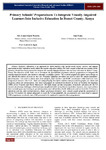Primary Schools’ Preparedness To Integrate Visually Impaired Learners Into Inclusive Education In Bomet County, Kenya

View/
Date
2016Author
Maemba, Lynner Sophie
Maina, Anne
Ogola, Fredrick O.
Metadata
Show full item recordAbstract
Inclusive Education is an approach in which learners with special needs receive services and support
appropriate to their individual needs within the regular education setting. The study sought to find out how regular public
primary schools have been prepared to integrate the visually impaired learners into inclusive education in Bomet County,
Kenya. The objectives of the study was to investigate the determinants of primary schools’ preparedness to integrate the
visually impaired learners into inclusive education in primary schools. The research adopted descriptive survey design as
this allowed description of issues as they are. Purposive sampling procedure was used to select the sample population.
Questionnaires were used to obtain data from teachers, head teachers and EARC coordinators while interviews were
designed for learners with V.I.C. Data was analyzed using descriptive statistics and presented in graphs, pie-charts and
frequency tables for interpretation. The study was pegged on constructivist theorist of Zone of Proximal Development
(ZPD) of Lev Vygotsky and Maria Montessori. The study found out that integration of inclusive education for the V.I
learners faced many challenges which included; insufficient skills by teachers to teach these learners, since most of them
have not undergone any training in special education, most did not have braille skills and could not teach the V.I learners
effectively with the other normal learners. Major conclusions therefore were: schools should adapt the environment to
suit the V.I, teachers be trained adequately to teach the V.I meaningfully, the government to give more fund to support
SNE programmes in schools, more SNE personnel to be employed to supervise these programmes.
Collections
- School of Education [203]
